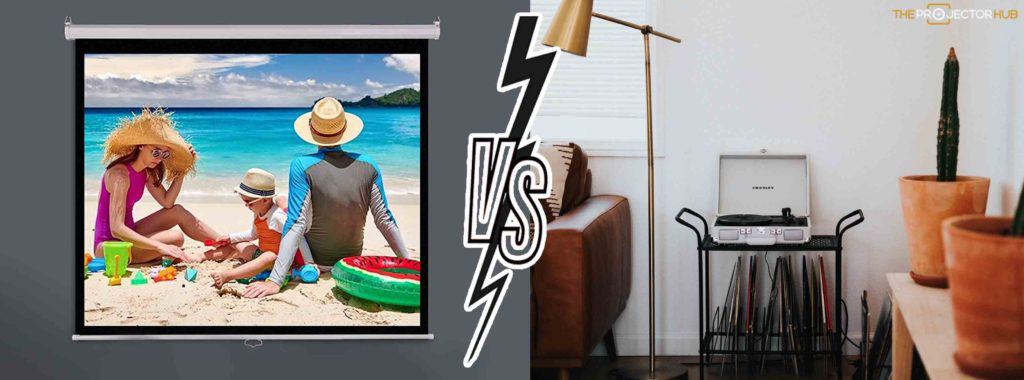 When considering whether to use a projector screen or another surface for projecting, there are a few things you need to take into account. Different surfaces will give different results regarding image quality and viewing distance. Remember, the main objective is to have as clear an image as humanly possible, meaning that things such as high definition quality are key.
When considering whether to use a projector screen or another surface for projecting, there are a few things you need to take into account. Different surfaces will give different results regarding image quality and viewing distance. Remember, the main objective is to have as clear an image as humanly possible, meaning that things such as high definition quality are key.
Now, what is the difference between a wall versus a screen when using a projector you ask? Bare walls can be used to project images onto but the quality simply isn’t as good as that provided by a projector screen. Walls don’t reflect light as well as projector screens, negatively effected the clarity of images projected onto the screen. Not only that but wall surfaces aren’t as smooth as screens and can blur or distort images.
Projectors can often output a clear, bright image perfect for showing a presentation or movie. But is a projector screen better than a wall? We’ll explore the pros and cons of each option and help you decide which is best for you.
Is A Projector Screen Better Than A Wall: Which One Is Best?
What are the advantages of a projector screen?
A projector screen is a unique surface that reflects projected light toward the viewer. Typical walls do not come with this special coating, meaning that images reflected onto this wall will not be as bright as those displayed on a screen. The screen can provide many advantages over projecting onto a wall, including:
Improved image quality:
Projector screens provide a flat, smooth surface that reflects light evenly. The screen can minimize the distortion and other artifacts that can occur when projecting onto a textured or curved surface. To get a better understanding of this, run your hand along a wall, you will likely feel slight bumps and grooves in it. These imperfections can result in shadows appearing on the image inevitably resulting in the image being less crisp and bright.
This doesn’t really matter if you invested in a less expensive projector with low image quality. But it can affect the image quality of a higher quality projector with a higher image quality.
Increased brightness:
A projector screen can also help to increase the brightness of the image. This is because the screen material reflects more light toward the viewer than a wall would. For a better understanding of this consider the term screen gain.
Screen gain, to put it simply, is the brightness of the image that is reflected off of the screen – in essence, it measures the reflectivity of a surface. This number can is a ratio of light that is reflected back off a surface from a light source.
Now, a screen (surface) that has a gain of 2.0 means that 2.0 times the amount of light will be reflected back from the surface. If 3,000 lumens of light are shone onto a screen with a gain of 2.0, 6,000 lumens of light will come back from the surface.
Wider viewing angles:
A projector screen can provide a wider viewing angle than a wall, making it easier for everyone in the room to see the image. The viewing angle is a about where an individual can sit in respect to the screen and still get an evenly lit, bright image.
Reduced glare:
A screen can also help reduce the amount of glare produced by the projector. The screen can make it easier to see the image, especially in rooms with bright lights.
Certain projector screens are better at doing this than others – there are light rejecting screens that diffuse reflection and eliminate spotlighting.
Aspect ratio:
Most projector screens have a standard 16:9 aspect ratio. This can be limiting if you want to project an image with a different aspect ratio, such as a movie.
Detailed guidelines about: Which Aspect Ratio Is The Best And Why?
For a better understanding of what an aspect ratio is look to this example:
An aspect ratio of 1:1 means that for every 1 unit of horizontal measurement there is an equal unit of vertical measurement. An aspect ratio of 4:3 means that for every 3 units of measure of height there will be 4 equal units of measurement for width.
Easy to set up:
Projector screens can be quick and easy to set up. Some screens even come with their stand, so you don’t need to worry about mounting them on a wall.
What are the disadvantages of a projector screen?
Projector screens can provide several advantages over other surfaces but also have a few potential drawbacks. These can include:
Cost:
Projector screens can be more expensive than other surfaces (like simply painting a wall white or grey for projection). This is because they’re designed specifically for use with projectors and usually need to be purchased separately.
Size:
Projector screens can also be larger and more cumbersome than other surfaces. This can make them difficult to transport and set up in small spaces.
Difficulty cleaning:
The smooth surface of a projector screen can make it difficult to clean. Dust and other debris can quickly become trapped on the surface, which can impact the quality of the image. You can’t just scrub a projector screen clean, you have to use specially made equipment to clean it, like a microfiber cloth and compressed air.
Aside from the literal cleaning aspect of it, you also have to worry about the screen getting wrinkles, something you can get out of a screen but will take time to do.
If you leave a screen dirty (with dust and oils) for too long know that it can leave permanent stains on the screen.
To clean a projector screen you’ll usually need:
- Masking tape
- Cotton swabs
- Isoproyl alcohol
- Dish soap
- Latex gloves
- Microfiber cloths or lint-free cotton
- A bowl
In some case you’ll need
- Foam brushes
- Pressurized air
- All-purpose surface cleaner
- Large pencil erasers
By looking at the list you can easily see how expensive cleaning a projector screen can be.
What are the advantages of a wall?
There are several advantages to using a wall as a projector screen, as opposed to a traditional screen.
Large screen:
A wall can provide a much larger screen than a traditional projector screen. This is especially beneficial if you project images or videos that require a large viewing area.
No wrinkles:
Another advantage of using a wall as a projector screen is that there are no wrinkles. Traditional screens can often get wrinkled or creased, which can affect the quality of the projection.
Flexibility:
Another advantage of using a wall as a projector screen is its flexibility. You can easily adjust the projection area size by moving the projector closer or further away from the wall. You can also move the projector around to create different angles and shapes.
Cost:
Finally, one of the main advantages of using a wall as a projector screen is the cost. Projector screens can be quite expensive, whereas using a wall is a much more affordable option. You won’t have to replace a wall as often as a traditional screen.
What are the disadvantages of the wall?
There are also several disadvantages of using a wall as a projector screen.
Permanent installation:
Once you have set up your projector, you won’t be able to move it around easily. The wall screen can be problematic if you change the projector’s position.
Texture:
Using a wall as a projector screen is the texture. Depending on the type of wall, the texture may cause the projected image to be distorted. Smooth, flat walls are the best option for projecting images.
Color of the wall:
If the color of the wall is not a neutral white (or grey) , it can effect the quality of the projection. Light colors are generally the best option for projector screens.
We’ll look at some of the most popular colors for projection screens and why. We’ll also go over the advantages and disadvantages of various colors to determine which is best for your needs.
So read now: Which Color Is Best For Projector Screen?
Conclusion Paragraph: Is A Projector Screen Better Than A Wall?
There are pros and cons to using a projector screen or a wall as your projection surface. A projector screen is designed specifically for use with a projector and can provide several advantages, such as a standard aspect ratio and easy setup.
However, projector screens can be more expensive than a wall and may be more difficult to clean. Additionally, the size of a projector screen can be limiting.
On the other hand, a wall can provide a much larger projection surface than a screen and is less likely to get wrinkled or creased. Additionally, walls are more affordable than projector screens and can be easily adjusted to create different shapes and sizes.
However, once you have set up your projector, it will be more difficult to move it around, and the wall’s texture may cause the projection to be distorted. Additionally, the wall’s color can affect the projection’s quality.
Using a projector screen or a wall depends on personal preference and specific needs. A wall may be the better option if you need a large projection surface or are on a budget. However, a projector screen may be the better choice if you need an easy-to-use surface that provides a standard projection.
